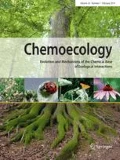References
Baker (1986) Material Safety Data Sheet. New Jersey: J T Baker Chemical Company
Bennett ATD, Clayton DH, Speight MR, Cuthill IC (1998) No evidence for ectoparasite reduction by anting. Avian Biol 29: in press
Budavari S (1989) The Merck Index and Encyclopedia of Chemicals, Drugs, and Biologicals. 11th ed. New Jersey: Merck Publications
Buschwinger A, Maschwitz U (1986) Defensive behavior and defensive mechanisms in ants. Pp 95–150in Hermann HR (ed.) Defensive Mechanisms in Social Insects. New York: Praeger
Catzeflis F (1979) Etude qualitative et quantitative de l'avifaune de la pessiere jurassienne du Chalet a Roch, Vaud. Oiseaux 35:75–84
Chisholm AH (1959) The history of anting. Emu 59:101–130
Hackenberger F (1988) Pp 476–478in Dukes MNG (ed.) Meylers Side Effects of Drugs. 11th ed. NL-North-Holland: Elsevier
Haemig PD (1994) Effects of ants on the foraging of birds in spruce trees. Oecologia 97:35–40
Haemig PD (1996) Interference from ants alters the foraging ecology of great tits. Behav Ecol Sociobiol 38:25–29
Hölldobler B. (1978) Ethological aspects of chemical communication in ants. Adv in the Study of Behavior 8:75–115
Hölldobler B, Wilson EO (1992) The Ants. D-Heidelberg: Springer-Verlag
Judson OP, Bennett ATD (1992) ‘Anting’ as food preparation: formic acid is worse on an empty stomach. Behav Ecol Sociobiol 31:437–439
Kelso L (1946) Irradiation, vitamin D, preening and anting. Biol Leafl 35:1–2
Liesivuori J, Kosma VM, Naukkarinen A, Savolainen H (1987) Kinetics and toxic effects of repeated intravenous dosage of formic acid in rabbits. Brit J Exp Path 68:853–61
Löfqvist J (1976) Formic acid and saturated hydrocarbons as alarm pheromones for the antFormica rufa. J Insect Physiol 22:1331–1346
Reynolds J, Prasad A (1982) Martindale, the Extra Pharmacopoeia. GB-London: The Pharmaceutical Press
Simmons, KEL (1966) Anting and the problem of self-stimulation. J Zool Lond 149:145–162
Simmons KEL (1985) Anting. Pp 19in Campbell B, Lack E (eds) A Dictionary of Birds. South Dakota: Vermillion
Whitaker LM (1957) A resume of anting, with particular reference to a captive orchard oriole. Wilson Bull 69:195–262
Author information
Authors and Affiliations
Rights and permissions
About this article
Cite this article
Bennett, A.T.D., Lloyd, M.H. & Cuthill, I.C. Ant-derived formic acid can be toxic for birds. Chemoecology 7, 189–190 (1996). https://doi.org/10.1007/BF01266312
Issue Date:
DOI: https://doi.org/10.1007/BF01266312

